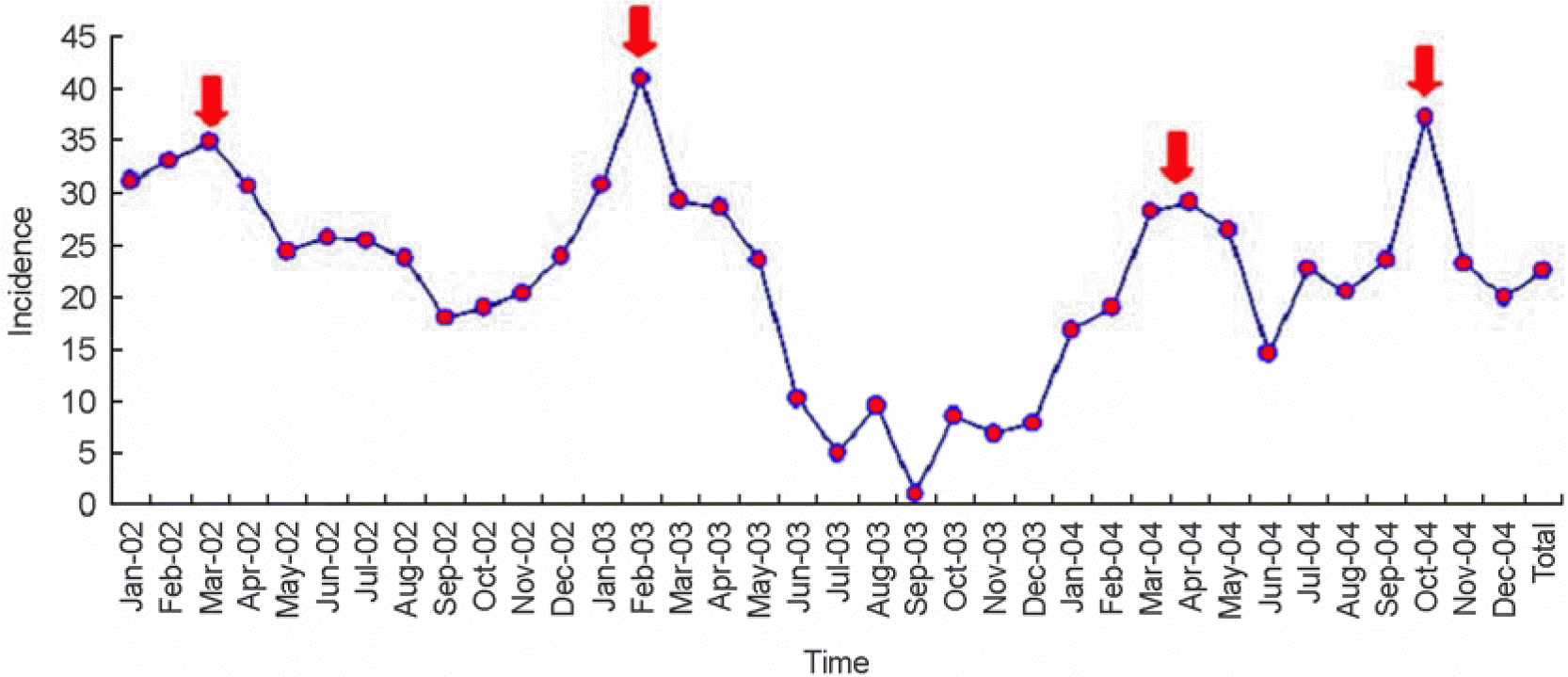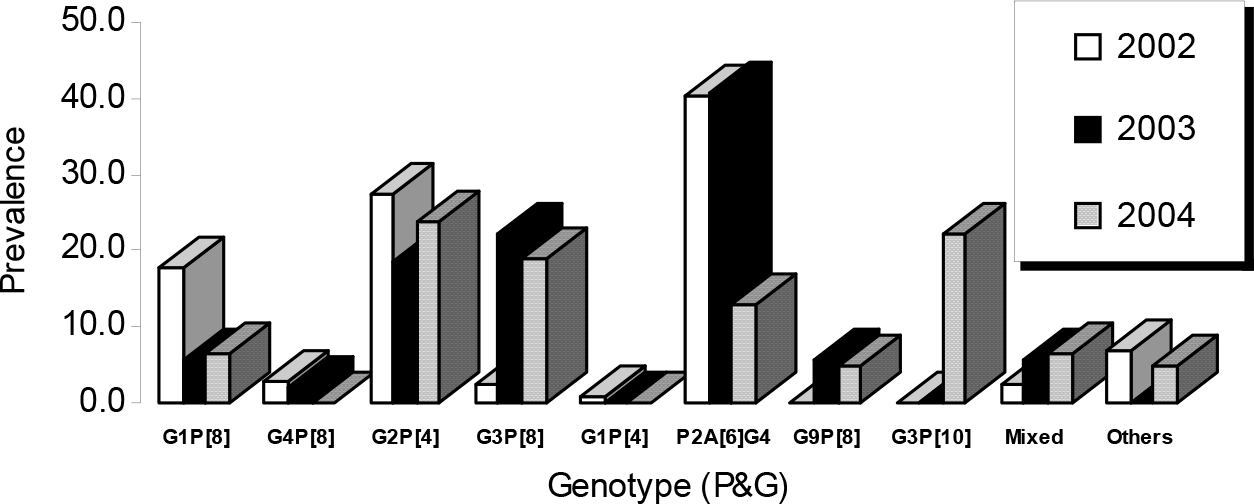Abstract
This study has focused on genetical patterns of rotavirus positives on diarrhea patients in Incheon. Fecal specimens collected from January 2002 to December 2004 from patients with diarrhea in seven localities in Incheon were screened for group A rotavirus by RT-PCR. To survey the prevalence of group A rotavirus infection and distribution of P (VP4) and G (VP7) genotypes of rotaviruses in Incheon, we performed the nested RT-PCR using rotavirus ELISA positive samples. Among a total of 4,865 samples investigated, 1,100 samples (22.6%) were positive. The predominant genotypes of 293 RT-PCR positive samples were confirmed as G4P[6] (101 samples, 34.5%) followed by G2P[4] (73 samples, 24.9%), G1P[8] (38 samples, 13.0%), G3P[8] (28 samples, 9.6%), G3P[10] (14 samples, 4.8%), G4P[8] (6 samples, 2.0%) and G9P[8] (6 samples, 2.0%). Mixed types and untypable types were 3.8% and 5.1%, respectively. The most prevalent types in 2002, 2003 and 2004 were G4P[6] (71 samples, 40.3%), G4P[6] (22 samples, 40.7%) and G2P[4] (15 samples, 22.2%) respectively. This is the first nationwide genoepidemiological study for determining the prevailing of genotypes of rotaviruses in Incheon. The genetic analysis for investigating sequence variations among group A rotavirus strains in this study would provide the useful information to establish the preventing strategy of human rotaviruses and of developing vaccines which will be used in Korea.
Go to : 
References
1). 김경희, 양재명, 주세익, 조영걸, Glass RI, 조양자. Importance of rotavirus and adenovirus types 40 and 41 in acute gastroenteritis in Korean children. J Clin Microbiol. 28:2279–2284. 1990.
2). 김동수, 박범수, 정동혁, 안재문, 김철중, 강신영. 국내 일부지역 설사환자의 로타바이러스 감염실태 및 분리 동정. 대한소아과학회지. 42:501–509. 1999.
3). 김운호. 국내에서 유행하는 A군 로타바이러스의 유전 자형 분포 및 염기서열 분석. 중앙대학교 석사논문. 2002.
4). 김효헌, 강성훈, 김원용. 서울지역 영아 설사환자로부터 분리한 로타바이러스 유전자형 및 G9 VP7 유전자 염기 서열. J Bacteriol Virol. 35:67–74. 2005.
5). 박선경. 대전지역 설사환자의 병원미생물학적 요인과 Rotavirus 유전자분석에 관한 연구 충남대학교 대학원. 박사학위논문. 2004.
6). 장지민, 김미정, 정혜원, 박대원, 손장욱, 손창성, 이승 은, 김민자. 신생아실 로타바이러스 유행의 역학적 특 성과 효과적인 조절 대책에 관한 연구. 감염과 화학요 법. 37:311–318. 2005.
7). 정재근. 광주지역에서 발생한 감염성 설사질환의 병원체 검출 및 분석 전남대학교 대학원. 박사학위논문. 2003.
8). Beards G, Desselberger U, Flewett TH. Temporal and geographical distributions of human rotavirus serotypes, 1983 to 1988. J Clin Microbial. 27:2827–2833. 1989.

9). Bern C, Martines J, Zoysa I, Glass RI. The magnitude of the global problem of diarrheal disease: a ten-year up-date. Bull WHO. 70:705–714. 1992.
10). Gentsch JR, Glass RI, Woods P, Gouvea V, Gorziglia M, Flores J, Das BK, Bhan MK. Identification of group A rotavirus gene 4 types by polymerase chain reaction. J Clin Microbiol. 30:1365–1373. 1992.

11). Gouvea V, Glass RI, Woods P, Taniguchi K, Clark HF, Forrester B, Fang YZ. Polymerase chain reaction amplification and typing of rotavirus nucleic acid from stool specimens. J Clin Microbiol. 28:276–282. 1990.

12). Guilermo M, Ruiz P. Safety and Efficacy of an Attenuated Vaccine against Severe Rotavirus Gastroenteritidis. the New England Journal of Medicine. 354:11–22. 2006.
13). Hwa-Gan HC, Perry FS, Joel AMPH, Dale LM, RPGER I. Intussusception, Rotavirus Diarrhea, and Rotavirus vaccine Use Among Children in New York State. PEDIATRICS. 108:54–60. 2001.
14). Hoshino Y, Sereno MM, Midthum K. Independent segregation of two antigenic specificities (VP4 and VP7) involved in neutralization of rotavirus infectivity. Proc Natl Acad Sci USA. 82:8701–8704. 1985.
15). Irene PS, María JG, Mireya P, Vito P, Ana MR, Rosabel G, Walter C, Yasutaka H, Albert Z. Efficacy of the Rhesus: Efficacy of the Rhesus Rotavirus-based Quadrivalent Vaccine in Infants and Young children in Venezuela. N Engl J Med. 337:1181–1187. 1997.
17). Kang JO, Kim CR, Kilgore PE, Choi TY. G and p geno-typing of human rotavirus isolated in a University hospital in Korea: implications for nosocomial infections. Korean Med Sci. 21(6):983–988. 2006.

18). Kapikian AZ, Flores J, Hoshino Y. Rotavirus: The Major etiologic agent of severe infantile diarrhea may be controllable by a “Jennerian” approach to vaccination. J Infect Dis. 153:815–822. 1986.

19). Kapikian AZ, Wyatt RG, Dolin R. Visualization by immune electron microscopy of a 27-nm particle associated with acute infectious nonbacterial gastroenteritis. J Virol. 10:1075–1081. 1972.

20). Martella V, Ciarlet M, Camarda A, Pratelli A, Tempesta M, Greco G, Cavalli A, Elia G, Decaro N, Terio V, Bozzo G, Camero M, Buonavoglia C. Molecular characterization of the VP4, VP6, VP7, and NSP4 genes of lapine rotaviruses identified in Italy emergence of a novel VP4 genotype. Virology. 314:358–370. 2003.

21). Matty AS, Marion PG, Koopmans M, Laetitia M, Kortbeek , Leeuwen NJ, Bartelds AIM, Yvonne THP, van Duynhoven. Gastroenteritis in sentinel general practices, the Netherland. Emerg Infect Dis. 1:82–91. 2001.
22). Parashar UD, Hummelman EG, Bresee JS, Miller MA, Glass RI. Global illness and deaths caused by rotavirus disease in children. Emerg Infect Dis. 9:565–572. 2003.

23). Parashar U. Session1: Epidemiology and disease burden. Proceedings of the Sixth International Rotavirus Symposium. Mexico City,. 6:7–9. 2004.
24). Penina Haber, Chen Robert T., Zanardi Lynn R., Mootrey Gina T., Roseanne English, Miles Braun M.An Analysis of Rotavirus Vaccine Reports to the Vaccine Adverse Event Reporting System. PEDIATRICS. 113:353–359. 2004.
25). Prasad BV, Wang GJ, Clerx JP, Chiu W. Three-dimensional structure of rotavirus. J Mol Biol. 199:269–275. 1988.

26). Rahman M, Matthijnssens J, Nahar S, Podder G, Sack DA, Azim T, Van Ranst M. Characterization of a novel P[25], G11 human group A rotavirus. J Clin Microbiol. 43:3208–3212. 2005.
28). Timo V, David O. Safety and Efficacy of a pentavalent Human-Bovine (WC3) Reassortant Rotavirus Vaccine. the New England Journal of Medicine. 354:23–33. 2006.
Go to : 
 | Figure 1.The seasonal incidence of group A Rotavirus infections in Incheon during 2002∼2004. |
Table 1.
The nucleotide sequences of primers used for genotyping of group A Rotavirues
Table 2.
The distribution of genotypes of group A Rotaviruses in Incheon (2002∼2004)




 PDF
PDF ePub
ePub Citation
Citation Print
Print



 XML Download
XML Download